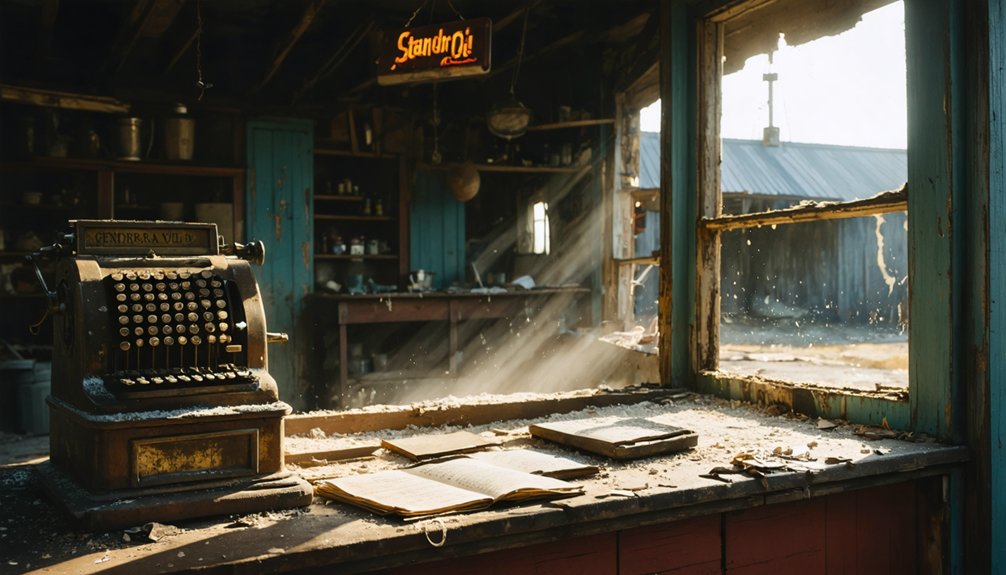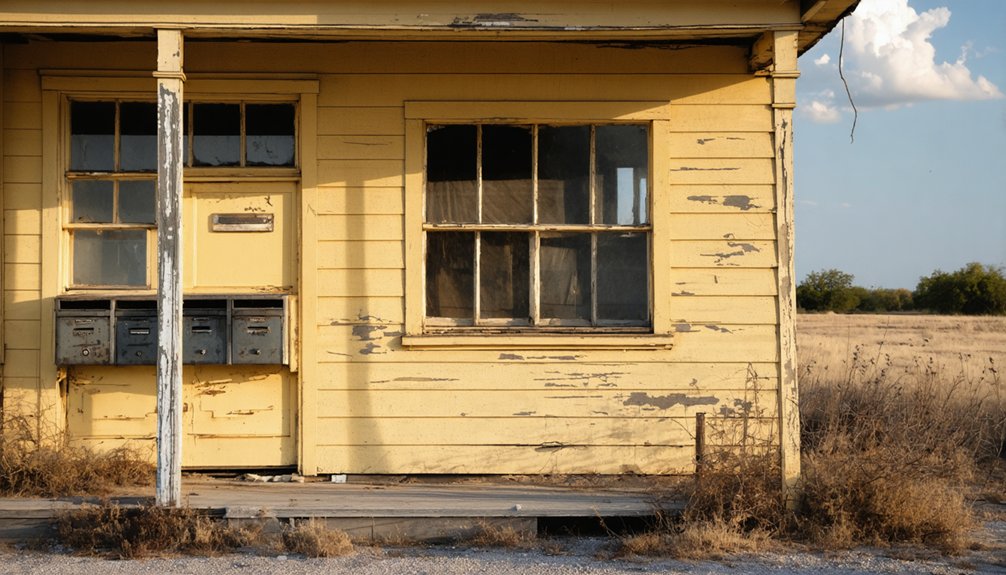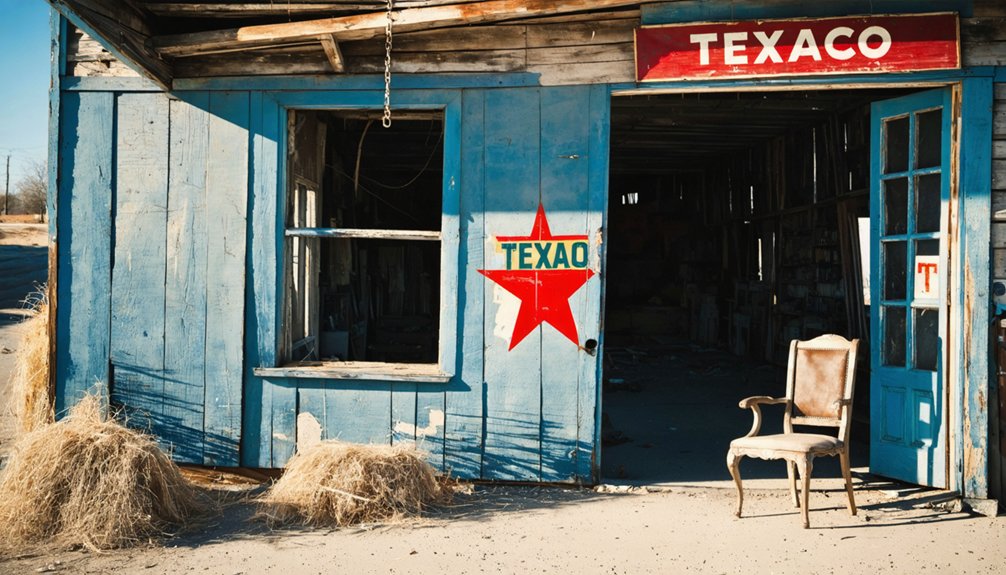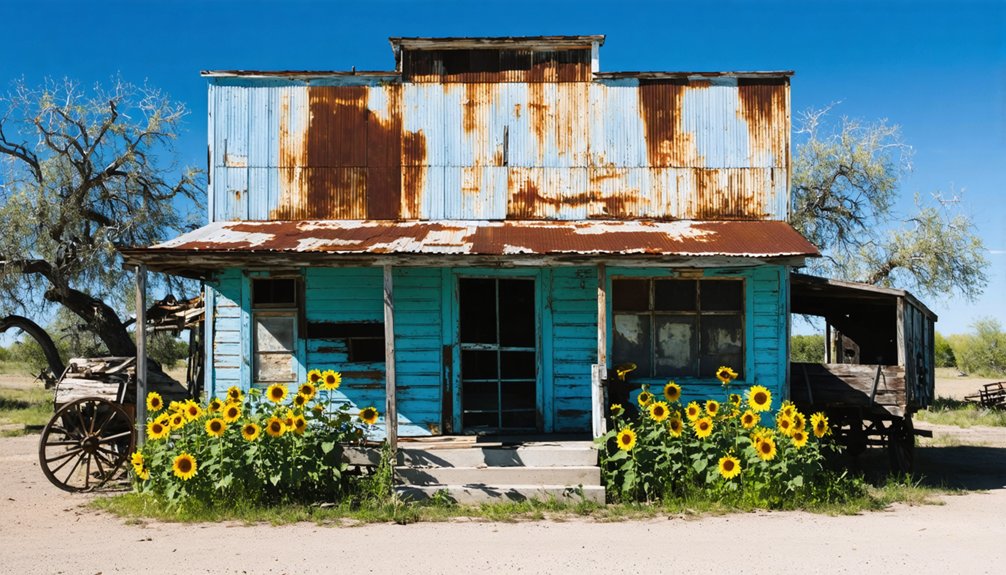You’ll find Sycamore, Texas in Wise County at coordinates 33°19′25″N 97°29′24″W, where it emerged as a frontier settlement in the 1880s. The town, named for its abundant sycamore trees, established its post office in 1894 under postmaster David S. Cox. The community thrived briefly with two general stores, a blacksmith shop, and a cotton gin until the post office’s closure in 1902 marked its decline. The town’s ruins and historic landmarks hold untold stories of Texas’s pioneering spirit.
Key Takeaways
- Sycamore, Texas emerged in Wise County during the late 19th century, named after the abundant sycamore trees in the area.
- The town’s post office operated from 1894 to 1902, with David S. Cox serving as the first postmaster.
- Local businesses included two general stores, a blacksmith shop, and a cotton gin that served nearby farming communities.
- A historic sycamore tree from the 1860s served as the town’s primary landmark, though its exact location remains uncertain.
- The community declined after the post office closure in 1902, with businesses shuttering and families relocating elsewhere.
Origins and Early Settlement
The late 19th century saw the emergence of Sycamore, Texas, a small settlement in Wise County nestled northeast of Decatur and south of Greenwood.
You’ll find its coordinates at 33°19′25″N 97°29′24″W, where pioneer experiences shaped the community’s character among the abundant sycamore trees that gave the town its name.
While records don’t pinpoint an exact founding date, settlers arrived in the 1880s, following typical western Texas settlement patterns.
They established roots in this promising location, building their lives around agriculture and local trade. The town is located in Kinney County, making it part of Texas’s southwestern border region.
Like many of Texas’s over 1,000 ghost towns, Sycamore represented the dreams and aspirations of its early settlers.
The community’s growth reflected the independent spirit of early Texas settlers, with the establishment of essential services coming to fruition by 1894 when David S. Cox became the first postmaster of the newly established post office.
Life in Late 19th Century Sycamore
Life in late 19th century Sycamore centered around a small but bustling commercial district, where two general stores and a blacksmith shop served local residents’ daily needs.
You’d find the local cotton gin processing harvests from nearby farms, while the newly established post office, opened in 1894, kept you connected to the wider world.
Community dynamics revolved around the schoolhouse, which served triple duty as an education center, church meetinghouse, and gathering place.
The schoolhouse stood as Sycamore’s heart, where children learned, worshippers prayed, and neighbors came together as one community.
The town’s name came from the Ancient Greek word sykómoros, reflecting the abundance of these trees in the area.
Though educational challenges were evident with only seven students enrolled after 1910, the building’s multiple uses highlighted Sycamore’s resourceful spirit.
The tight-knit community made the most of limited infrastructure, with residents supporting each other through shared spaces and services typical of frontier Texas settlements.
Like many rural Texas communities, Sycamore’s residents understood the importance of preserving local history through stories and records passed down through generations.
Notable Local Landmarks
If you visit Sycamore today, you’ll find its most impressive landmark is a majestic Sycamore tree from the 1860s standing in the old downtown district, serving as a living witness to the town’s earliest settlement period.
Near the tree, you can spot the original post office site, though only traces remain of what was once a crucial communication hub for the community.
The location of an early cotton gin, which processed the area’s primary agricultural product, can still be identified among the scattered ruins, marking where local farmers once brought their harvests. A nearby concrete outhouse structure stands as a remnant of the town’s past, later repurposed into a residence before ultimately burning down. Similar to other ghost towns like Helena, visitors can explore the area by walking the fence line to view the historical remains.
Historic Sycamore Tree
Standing at the heart of what was once Sycamore, Texas, a majestic old sycamore tree served as both the town’s namesake and primary landmark during its brief existence.
While specific details about this historic tree have been lost to time, its presence likely offered welcomed shade to early settlers and travelers in the region. Similar to old adobe structures in other Texas ghost towns, nature has taken its toll on this historic landmark.
Local folklore tales may have once circulated about this natural monument, but like the town itself, these stories have faded into obscurity.
Today, if you’re searching for this historic sycamore tree that gave the settlement its identity, you’ll find that its exact location and fate remain uncertain.
Whether the tree still stands or has long since fallen, it remains a symbol of Texas’s countless ghost towns and their vanished histories. Much like Great Depression era towns, Sycamore offers a glimpse into forgotten Texas history.
Original Post Office Site
Mail service in Sycamore, Texas centered around a modest post office that operated until its closure in 1902.
You’ll find that this postal service wasn’t just a place to send and receive mail – it served as an essential community hub where locals gathered and connected with the outside world.
The building’s architecture matched the rural Texas style of the late 1800s, standing as a symbol of the town’s once-thriving presence.
Like many rural post offices of its time, it played a significant role in Sycamore’s economic and social fabric.
When the post office closed its doors in 1902, it marked a turning point in the community’s decline, reflecting the broader pattern of rural Texas towns facing similar fates during that era.
Similar to the Thurber Post Office, the building served as a crucial link for residents to send money abroad to support their distant family members.
Much like the town of Ayr, Texas, the closure of the post office proved to be a critical setback that contributed to the community’s eventual abandonment.
Early Cotton Gin Location
While the post office marked one cornerstone of Sycamore’s community life, the town’s true economic foundation began with Dr. James S. Wills’ cotton gin in 1848.
You’ll find this pioneering facility was one of the region’s earliest gin innovations, established well before the Civil War transformed Texas agriculture.
The gin’s significance to Sycamore’s growth can’t be overstated:
- It relied on mule power to operate the machinery, representing early industrial technology in rural Texas.
- The facility attracted 508 residents by 1860, serving as both an economic hub and social gathering point.
- Local farmers depended on the gin to process their cotton crops, making it the centerpiece of community commerce.
The gin’s location became a natural meeting point where farmers, workers, and families gathered, shaping Sycamore’s early identity as a cotton-producing powerhouse.
Economic Activities and Commerce

While cotton farming played a minor role in Sycamore’s early economy, you’ll find records showing the town’s gin operated intermittently to serve scattered agricultural plots in the region.
You’d discover the timber industry’s dominance largely overshadowed traditional farming activities, with most residents tied to sawmill operations rather than agricultural pursuits.
The town’s blacksmith shops primarily supported the lumber industry’s equipment needs, though they’d occasionally service local farmers’ tools and machinery.
Local Agriculture Production
Throughout its history, Sycamore’s agricultural economy thrived on diverse crop production and livestock operations that adapted to West Texas’s challenging environment. Early farmers practiced crop rotation between corn, cotton, and cantaloupe, while later incorporating sorghum to maintain soil health.
You’d find extensive livestock management operations, including large dairy farms with over 300 Jersey cattle and substantial poultry production facilities.
The region’s agricultural success relied on three key factors:
- Modern mechanization that replaced animal power and increased farming efficiency
- Robust infrastructure including barns, silos, and cold storage facilities
- Strategic railroad connections that enabled efficient distribution of agricultural products
These elements helped Sycamore’s farmers overcome harsh environmental conditions while maintaining productive agricultural operations well into the mid-20th century.
Cotton Gin Operations
At the heart of Sycamore’s agricultural commerce stood its cotton gin operations, which powered the town’s economic engine from the 1880s through the mid-1900s.
You’d find the gin complex buzzing with activity during harvest season, as farmers brought their cotton to be processed by innovative ginning machinery descended from Holmes’ saw disk designs. The noisy operation required workers to communicate through hand signals while separating cotton fiber from seeds.
The gin wasn’t just a processing facility – it served as the town’s economic hub, attracting merchants, blacksmiths, and transporters.
Inside, operators mastered complex mechanical systems, from internal combustion engines to the vital scalehouse operations. These cotton gin innovations helped transform raw cotton into market-ready bales, connecting Sycamore’s farmers to broader commercial networks and supporting the town’s prosperity.
Blacksmith Trade Services
Since the mid-1890s, Sycamore’s blacksmith shop served as a significant economic cornerstone alongside its cotton gins and general stores.
You’d find the blacksmith’s skilled hands working tirelessly through blacksmith apprenticeship programs, ensuring essential knowledge passed down through generations. The shop became a bustling hub where community craftsmanship thrived, supporting every aspect of local life.
Key services included:
- Manufacturing and repairing essential tools, from plowshares to wagon parts
- Producing custom metalwork for local trades, including specialized tools for leatherworkers
- Shoeing horses and oxen important for transportation and farming
The blacksmith’s presence elevated Sycamore’s status as a service center, with farmers and travelers relying on their expertise for equipment maintenance and repairs.
You’d often find locals bartering goods or labor for the blacksmith’s invaluable services.
The Post Office Era

The post office in Sycamore played a significant role in the town’s development until its closure in 1902 marked the beginning of the community’s decline.
You’d have found this essential hub serving as more than just a mail station – it was the heartbeat of community connection, where you could send letters to loved ones and conduct important business transactions.
Once the post office closed, you would’ve witnessed the town’s swift transformation. The cotton gin relocated, businesses shuttered, and families moved away during the mid-1920s.
Like other Texas ghost towns such as Thurber and Girvin, Sycamore’s post office significance extended beyond mail service – it represented the town’s viability and economic health.
Without this critical infrastructure, the community’s social fabric unraveled, and the school eventually disbanded.
Natural Heritage and Sycamore Trees
While Sycamore’s post office marked its civic heart, the town’s namesake trees defined its natural character.
You’ll find these majestic sycamores along the region’s waterways, where their distinctive white-patched bark and sprawling canopies create natural landmarks. The sycamore ecology shaped the town’s development, offering both practical and cultural significance to early settlers.
- These fast-growing giants can live up to 600 years, providing lasting shade and wildlife habitat.
- Their wood proved valuable for crafting furniture, butcher blocks, and musical instruments.
- Their presence along rivers helped stabilize banks and marked reliable water sources for settlement.
You can still spot these resilient trees today, their peeling bark and massive branches standing as living monuments to the town’s natural heritage.
The Path to Abandonment

Like many rural Texas settlements, Sycamore’s decline began gradually in the early 1900s through a perfect storm of challenges.
You’ll find that shifting transportation patterns dealt the first blow when newer rail lines bypassed the town, redirecting crucial trade routes elsewhere. The economic decline accelerated as younger residents moved to larger cities seeking better opportunities, leaving behind an aging population that couldn’t sustain local businesses.
Infrastructure challenges sealed Sycamore’s fate. Without adequate investment in roads, utilities, and public services, the town couldn’t compete with growing neighboring communities.
Population shifts continued through the mid-1900s, driven by broader urbanization trends and technological changes that made the town’s traditional economic activities less viable.
What was once a promising settlement gradually transformed into another Texas ghost town, its abandoned buildings standing as silent witnesses to changing times.
Legacy in Wise County History
Significance of Sycamore’s legacy endures in Wise County’s historical tapestry, particularly through its late 19th-century development northeast of Decatur.
You’ll find the community’s historical significance reflected in its contributions to local commerce and community dynamics, which helped shape the county’s early development.
- The establishment of Sycamore’s post office in 1894 marked its importance as a communication hub.
- The town’s cotton gin and general stores showcased its essential role in the region’s agricultural economy.
- Churches and social structures formed the foundation of community life, influencing neighboring settlements.
While Sycamore’s businesses eventually moved to Decatur in the 1920s, you can still trace its impact through Wise County’s heritage preservation efforts.
The town’s story represents a significant chapter in the county’s evolution from frontier settlements to modern communities.
Preserving Sycamore’s Memory
Preserving Sycamore’s memory has become increasingly crucial as physical remnants of this Texas ghost town face modern challenges.
As time marches on, safeguarding what remains of Sycamore becomes vital to preserving this piece of Texas history.
You’ll find historic preservation efforts focused particularly on the iconic Outlaw Station, a 1929 petrified wood filling station that’s weathered decades of change and now faces potential impacts from TxDOT highway realignment plans.
You can access Sycamore’s history through digitized archives at the University of North Texas, where documentation efforts guarantee the town’s legacy endures beyond its physical remains.
Community involvement plays a critical role through educational programs and guided tours that showcase the site’s significance.
While legal protections help safeguard these historic resources, you’ll need to respect private property rights when visiting.
The preservation of Outlaw Station particularly demonstrates the ongoing balance between protecting heritage and accommodating progress.
Frequently Asked Questions
Are There Any Remaining Structures or Ruins Still Standing in Sycamore Today?
You’ll find limited historical architecture remaining, as most abandoned buildings haven’t survived. Only scattered foundation stones and a few crumbling walls mark where structures once stood in this remote location.
What Is the Current Population of the Sycamore Ghost Town Area?
You’ll find current demographics show a tiny handful of souls – likely fewer than 10 residents remain. Population trends reveal steady decline since the mid-1900s, with most folks having moved to larger cities.
Can Visitors Legally Access and Explore the Former Sycamore Town Site?
You’ll need to verify local property ownership and obtain permissions first, as ghost town regulations aren’t documented and no historical preservation protections exist. The site likely sits on private land requiring authorization.
Were There Any Notable Historical Events or Disasters in Sycamore?
You won’t find records of major disasters or notable figures in Sycamore’s history. The town’s historical significance lies in its quiet decline, typical of East Texas communities affected by industrial changes.
Do Any Descendants of Original Sycamore Settlers Still Live Nearby?
While descendant stories aren’t officially documented, you’ll find family ties endure through nearby Mahomet Christian Church and Mt. Horeb Masonic Lodge, where Smart, Stewart, and Williams families likely maintain connections.
References
- https://texascooppower.com/old-haunts/
- http://russellcushman.blogspot.com/2012/01/texas-ghost-town-and-pigs_12.html
- https://en.wikipedia.org/wiki/Sycamore
- https://en.wikipedia.org/wiki/List_of_ghost_towns_in_Texas
- https://www.wikiwand.com/en/articles/List_of_ghost_towns_in_Texas
- https://www.tshaonline.org/handbook/entries/sycamore-tx-newton-county
- https://www.tshaonline.org/handbook/entries/sycamore-tx-wise-county
- https://www.texasalmanac.com/places/sycamore-1
- https://www.youtube.com/watch?v=phjUE19A8HM
- https://texashighways.com/culture/history/what-the-heck-is-a-ghost-town/



